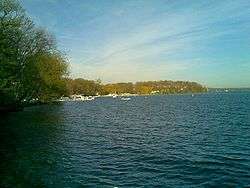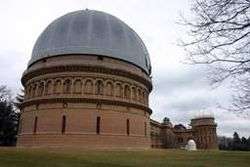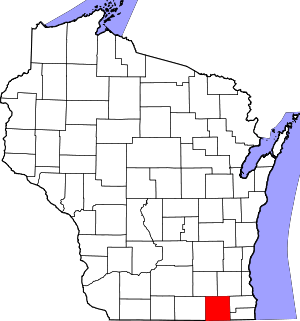Williams Bay, Wisconsin
Williams Bay is a village in Walworth County, Wisconsin, United States. The population was 2,564 at the 2010 census.
Williams Bay, Wisconsin | |
|---|---|
 Skyline over Geneva Lake | |
 Location of Williams Bay in Walworth County, Wisconsin. | |
| Coordinates: 42°34′27″N 88°32′37″W | |
| Country | |
| State | |
| County | Walworth |
| Area | |
| • Total | 2.78 sq mi (7.20 km2) |
| • Land | 2.78 sq mi (7.20 km2) |
| • Water | 0.00 sq mi (0.00 km2) |
| Elevation | 879 ft (268 m) |
| Population | |
| • Total | 2,564 |
| • Estimate (2019)[4] | 2,639 |
| • Density | 949.28/sq mi (366.55/km2) |
| Time zone | UTC-6 (Central (CST)) |
| • Summer (DST) | UTC-5 (CDT) |
| Area code(s) | 262 |
| FIPS code | 55-87200[5] |
| GNIS feature ID | 1576761[2] |
| Website | Official website |

History
Williams Bay is one of three municipalities on Geneva Lake. It was named for Captain Israel Williams[6] of Massachusetts, who, with several of his sons, settled in the area in 1837. Much of the surrounding area was settled in the early 19th century by surveyors plotting roadways from the East. It was a vacation spot for wealthy Chicagoans displaced by the Great Chicago Fire of 1871.
It is probably best known internationally for being home to the University of Chicago's Yerkes Observatory, which houses the world's largest refracting (lens) telescope, the great 40-inch. Construction of the Observatory began in 1895 and the 40-inch saw first light in May 1897. The Observatory's first Director was George Ellery Hale, who went on to establish Mount Wilson Observatory in Southern California.
Officials and students of Chicago-based George Williams College frequently met just west of the town of Williams Bay and later established a camp in the village on the shores of Geneva Lake. George Williams College folded in 1985 and is now part of Aurora University, which today maintains the campus.
Geography
Williams Bay is located at 42°34′27″N 88°32′37″W (42.574208, -88.543690).[7]
According to the United States Census Bureau, the village has a total area of 2.80 square miles (7.25 km2), all of it land.[8]
Demographics
| Historical population | |||
|---|---|---|---|
| Census | Pop. | %± | |
| 1920 | 436 | — | |
| 1930 | 630 | 44.5% | |
| 1940 | 717 | 13.8% | |
| 1950 | 1,118 | 55.9% | |
| 1960 | 1,347 | 20.5% | |
| 1970 | 1,554 | 15.4% | |
| 1980 | 1,763 | 13.4% | |
| 1990 | 2,108 | 19.6% | |
| 2000 | 2,415 | 14.6% | |
| 2010 | 2,564 | 6.2% | |
| Est. 2019 | 2,639 | [4] | 2.9% |
| U.S. Decennial Census[9] | |||
2010 census
As of the census[3] of 2010, there were 2,564 people, 1,061 households, and 706 families living in the village. The population density was 915.7 inhabitants per square mile (353.6/km2). There were 1,985 housing units at an average density of 708.9 per square mile (273.7/km2). The racial makeup of the village was 94.3% White, 0.6% African American, 0.3% Native American, 0.8% Asian, 0.1% Pacific Islander, 3.0% from other races, and 0.9% from two or more races. Hispanic or Latino of any race were 6.5% of the population.
There were 1,061 households of which 29.2% had children under the age of 18 living with them, 53.9% were married couples living together, 8.9% had a female householder with no husband present, 3.8% had a male householder with no wife present, and 33.5% were non-families. 28.3% of all households were made up of individuals and 9.8% had someone living alone who was 65 years of age or older. The average household size was 2.35 and the average family size was 2.87.
The median age in the village was 43.5 years. 22.8% of residents were under the age of 18; 6.3% were between the ages of 18 and 24; 22.9% were from 25 to 44; 30.1% were from 45 to 64; and 17.9% were 65 years of age or older. The gender makeup of the village was 48.2% male and 51.8% female.
2000 census
As of the census[5] of 2000, there were 2,415 people, 993 households, and 639 families living in the village. The population density was 912.6 people per square mile (351.9/km²). There were 1,772 housing units at an average density of 669.6 per square mile (258.2/km²). The racial makeup of the village was 98.18% White, 0.50% African American, 0.08% Native American, 0.33% Asian, 0.04% Pacific Islander, 0.70% from other races, and 0.17% from two or more races. Hispanic or Latino of any race were 3.73% of the population.
There were 993 households out of which 29.6% had children under the age of 18 living with them, 54.1% were married couples living together, 6.9% had a female householder with no husband present, and 35.6% were non-families. 30.4% of all households were made up of individuals and 12.2% had someone living alone who was 65 years of age or older. The average household size was 2.35 and the average family size was 2.96.
In the village, the population was spread out with 24.4% under the age of 18, 5.0% from 18 to 24, 26.7% from 25 to 44, 24.6% from 45 to 64, and 19.3% who were 65 years of age or older. The median age was 41 years. For every 100 females, there were 91.8 males. For every 100 females age 18 and over, there were 88.3 males.
The median income for a household in the village was $50,450, and the median income for a family was $60,573. Males had a median income of $45,750 versus $24,875 for females. The per capita income for the village was $26,231. About 5.3% of families and 7.2% of the population were below the poverty line, including 10.4% of those under age 18 and 7.8% of those age 65 or over.
Transportation
No public transportation presently serves Williams Bay, but until the 1960s, it was the terminus of the Chicago and North Western Railway. The line also had stops in Como, Lake Geneva, Genoa City, Richmond, and McHenry, Illinois. Kishwauketoe Nature Conservancy now stands on the site of the former railroad station and yards.
Education
The public schools include Williams Bay Elementary and Williams Bay High School. One private school, Faith Christian School, serves students in grades K-12.
George Williams College of Aurora University is located along the lake.
Recreation
Williams Bay has a lake-side nature conservancy, Kishwauketoe Nature Conservancy, along with a beach and a public boat launching facility.
Points of interest
Williams Bay is home to Yerkes Observatory, owned by the Department of Astronomy and Astrophysics at the University of Chicago. The observatory was designed by architect Henry Ives Cobb. Its Greco-Roman facade has intricate stonework and carvings. The university plans to cease operation of the observatory by October 1, 2018.
The Belfry Theatre, Wisconsin's first summer stock theater, was an active seasonal repertory company from the 1930s through the 1970s, and its buildings still stand at highways 50 and 67. Today it is the home of the Belfry Music Theatre.
Notable residents
- Edward Emerson Barnard, astronomer
- Subrahmanyan Chandrasekhar, astronomer
- George Ellery Hale, astronomer
- Dara Hobbs, operatic soprano
- Edwin Hubble, astronomer
- Gerard Kuiper, astronomer
- Thomas Lothian, Wisconsin legislator and college professor
- Otto Struve, astronomer
References
- "2019 U.S. Gazetteer Files". United States Census Bureau. Retrieved August 7, 2020.
- "US Board on Geographic Names". United States Geological Survey. October 25, 2007. Retrieved January 31, 2008.
- "U.S. Census website". United States Census Bureau. Retrieved November 18, 2012.
- "Population and Housing Unit Estimates". United States Census Bureau. May 24, 2020. Retrieved May 27, 2020.
- "U.S. Census website". United States Census Bureau. Retrieved January 31, 2008.
- Chicago and North Western Railway Company (1908). A History of the Origin of the Place Names Connected with the Chicago & North Western and Chicago, St. Paul, Minneapolis & Omaha Railways. p. 139.
- "US Gazetteer files: 2010, 2000, and 1990". United States Census Bureau. February 12, 2011. Retrieved April 23, 2011.
- "US Gazetteer files 2010". United States Census Bureau. Retrieved November 18, 2012.
- "Census of Population and Housing". Census.gov. Retrieved June 4, 2015.

